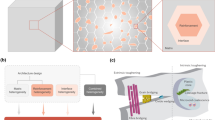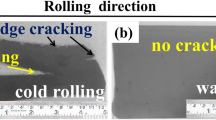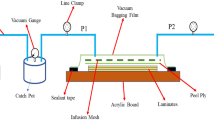Abstract
Loading and loading-unloading tests of a unidirectional reinforced Gr/Al metal matrix composite have been carried out using a self-designed tensile impact apparatus, and quasi-static tensile tests have been performed on the Shimadzu-5000 testing apparatus. The stress/strain curves of composites have been obtained in strain rate range from 0. 0005 s− 1 to 1300 s−1. The experimental results show that complete stress/strain curves of the material can be divided into two parts: the nonlinear elastic brittle deformation and residual deformation. The tests results also clearly indicate that the Gr/Al composite is a rate-sensitive material; namely the strength, failure strain and residual strength of composite all depend on strain rate. Statistical analysis and models were used to obtain the mechanical parameters for composites and their relationship with strain rate from experimental results. The simulated stress/strain curves from the model are in good agreement with the test data. The theoretical model and test results show that the shape parameter β and the scale parameter σ0 are both independent of strain rate. The constituent, Gr fibers in Gr/Al composites, can be regarded as a rate-insensitive material, and the strain rate effect of Gr/Al composites is mainly caused by the Al alloy matrix.
Similar content being viewed by others
References
Barbero, Ever J. and Kelly, Kevin W., 'Predicting High Temperature Ultimates Strength of Continuous Fiber Matel Matrix Composites', Journal of Composite, Materials 27(12), 1993, 1214-1237.
Rocher, J. P., Quensset, J. M., and Raslain, R. N., 'A New Casting Process for Carbon (or SiC-Based) Fiber-Aluminium Matrix Low-Cost Composite Materials', J. Mater. Sci. Lett. 4, 1985, 1527-1529.
Marrous, H. L., Interface Character in Al/Gr Metal Matrix Composites AD-A 127590.
Poteet, C. C. and Hall, I. W., 'High Strain Rate Properties of a Unidirectionally Reinforced C/Al Metal Matrix Composite', Material Science and Engineering A222, 1997, 35-44.
Nan-Ming Yen and Krempl, Erhard, 'The Influence of Cool-Down Temperature Histories on Residual Stresses in Fibrous Metal-Matrix Composites', Journal of Composite Materials 27(10), 1993, 973-995.
Yuanming Xia and Yuanxin Zhou, 'Recovery Experimental Techniques of Tensile Impact', ACTA Mechanica Sinica (English Series) 12(3), 1996, 243-250.
Yuanming Xia, Jianming Yuan and Baochang Yang, 'A Statistical Model and Experimental Study of the Strain-Rate Dependence of the Strength of Fibers', Composites Science and Technology 52, 1994, 499-504.
Author information
Authors and Affiliations
Rights and permissions
About this article
Cite this article
Zhou, Y., Xia, Y. The Experimental Study of the Strain-Rate Dependence of a Unidirectional Reinforced Gr/Al Metal Matrix Composite. Applied Composite Materials 6, 341–352 (1999). https://doi.org/10.1023/A:1008840426636
Issue Date:
DOI: https://doi.org/10.1023/A:1008840426636




